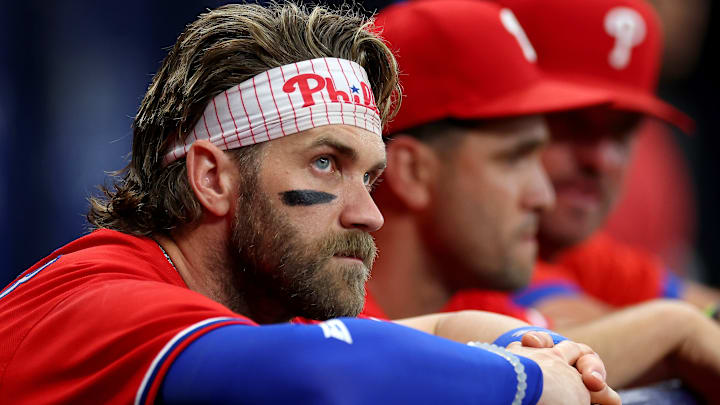Ever since he made his MLB debut back in 2012 with the Washington Nationals, Phillies outfielder Bryce Harper has made his mark and is nationally known to be a prolific power hitter. On average, he can be counted upon to give at least 30 home runs and 90 RBI of offensive output each season, as the two-time NL MVP, seven-time All-Star has shown consistently time and time again for the past decade.
However, for the 2023 season, something just doesn’t appear right for Harper. Through 56 games played this season, Harper has hit only three home runs in total, to go along with a measly 23 RBI, despite still hitting for a solid average at .290. Projected over an entire season, he would be on pace for a miserable nine home runs and 68 RBI year. The Phillies definitely weren’t expecting Harper to all of a sudden become Josh Harrison-like in terms of offensive output, and certainly at just the prime age of 30, father time shouldn’t be arriving that fast.
So what is wrong with Harper?
The main thing that comes to everyone’s mind obviously pertains to his recovery status from Tommy John surgery that he had last November to repair a partially torn UCL in his throwing arm. It was projected that his recovery time would lead up until at least the All-Star break. However, Harper made his miraculous comeback in early May this year, making history in the process as one of the fastest players ever to recover from Tommy John surgery.
But the question is, did he come back too soon? Instead of slowly ramping up his activity regime and building back up his stamina and power for a full recovery, by coming back so fast, has it done more harm than good for both Harper and the Phillies’ team?
Looking at the numbers, Harper did have a decent month of May, hitting .315 with an .893 OPS, with 18 runs scored, six doubles, three home runs, eight RBI and two stolen bases in just 24 games. So initial signs did point towards the fact he was back to full form. However, since then, Harper has struggled to produce any power numbers, with only seven more doubles and ZERO home runs since May 25th, which has definitely made the Phillies and their entire fanbase frustrated and worried at the same time.
Taking a further look at his Statcast advanced stat metrics, his average exit velocity and Hard Hit % are both at its lowest since 2016 at 90.8 mph and 41.7% respectively. More importantly, his launch angle is currently at a career low of 8.0, a far cry from his career average closer to 13, meaning he isn’t getting enough power and lift to drive the ball over the fence. Not only that, his ground ball rate is at the highest in his career at 46.8%, along with the fact he is no longer pulling the ball as much as he used to when making contact, but rather hitting many balls to the opposite field instead, which signifies he is not catching up to the speed of the pitches that he is facing.
It may be tough to take a star-caliber player like Harper out of the lineup for any significant chunk of time, but if the Phillies fully intend to compete for the postseason this year after their recent surge up the standings, it may be to their best interest to give Harper some rest or a brief rehab assignment to get him back up to speed and fully heal properly, so that he can be effective in the long run, rather than keep letting him play through whatever ailment that is affecting his ability to be his usual self.
To be honest, the last thing the Phillies would need is a long-term, permanent, powerless, ineffective Harper for the rest of this year and beyond as a result of bad injury rehabilitation. In the meantime, the Phillies should explore options to find an adequate backup for depth, especially now that they are deep in the playoff chase.
